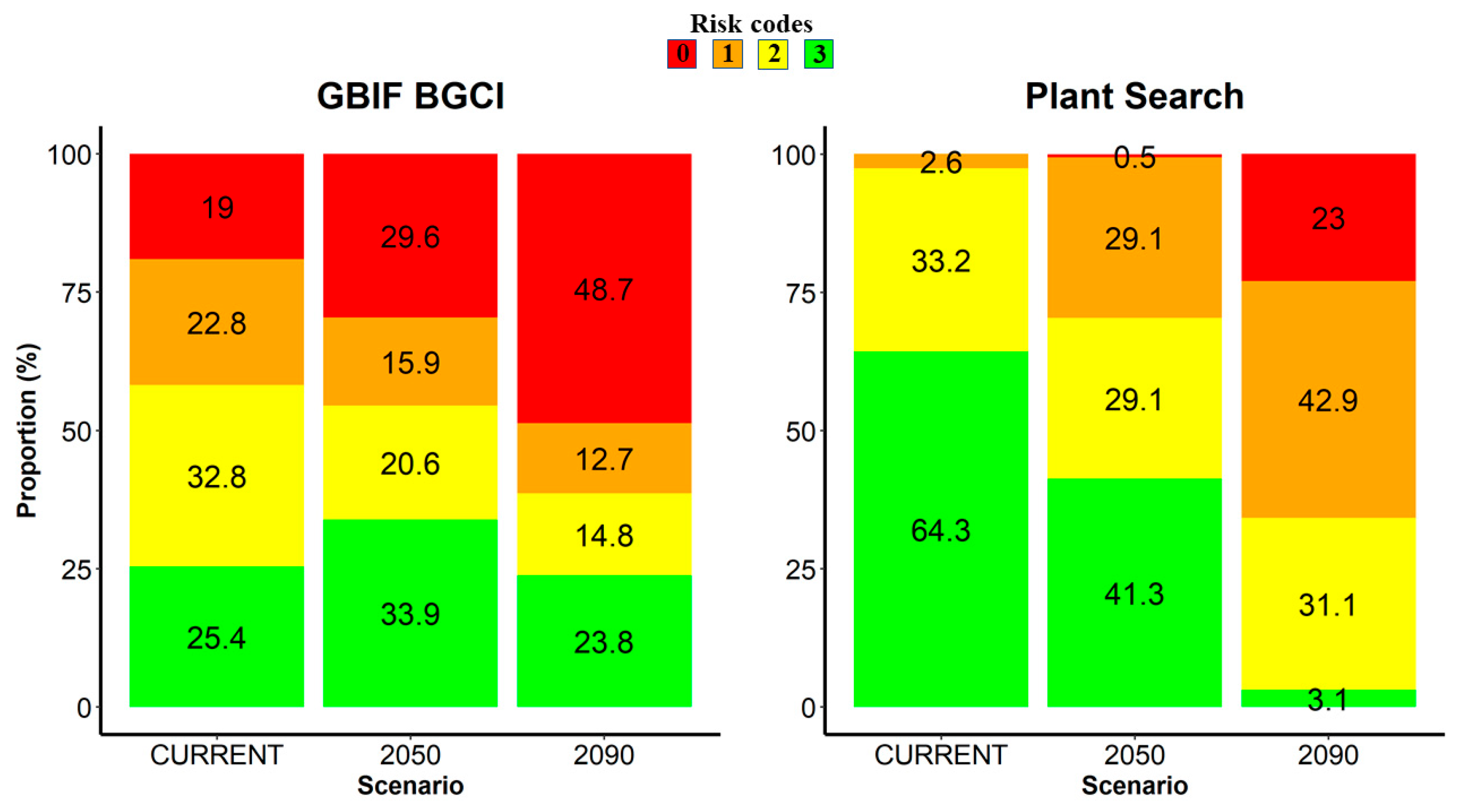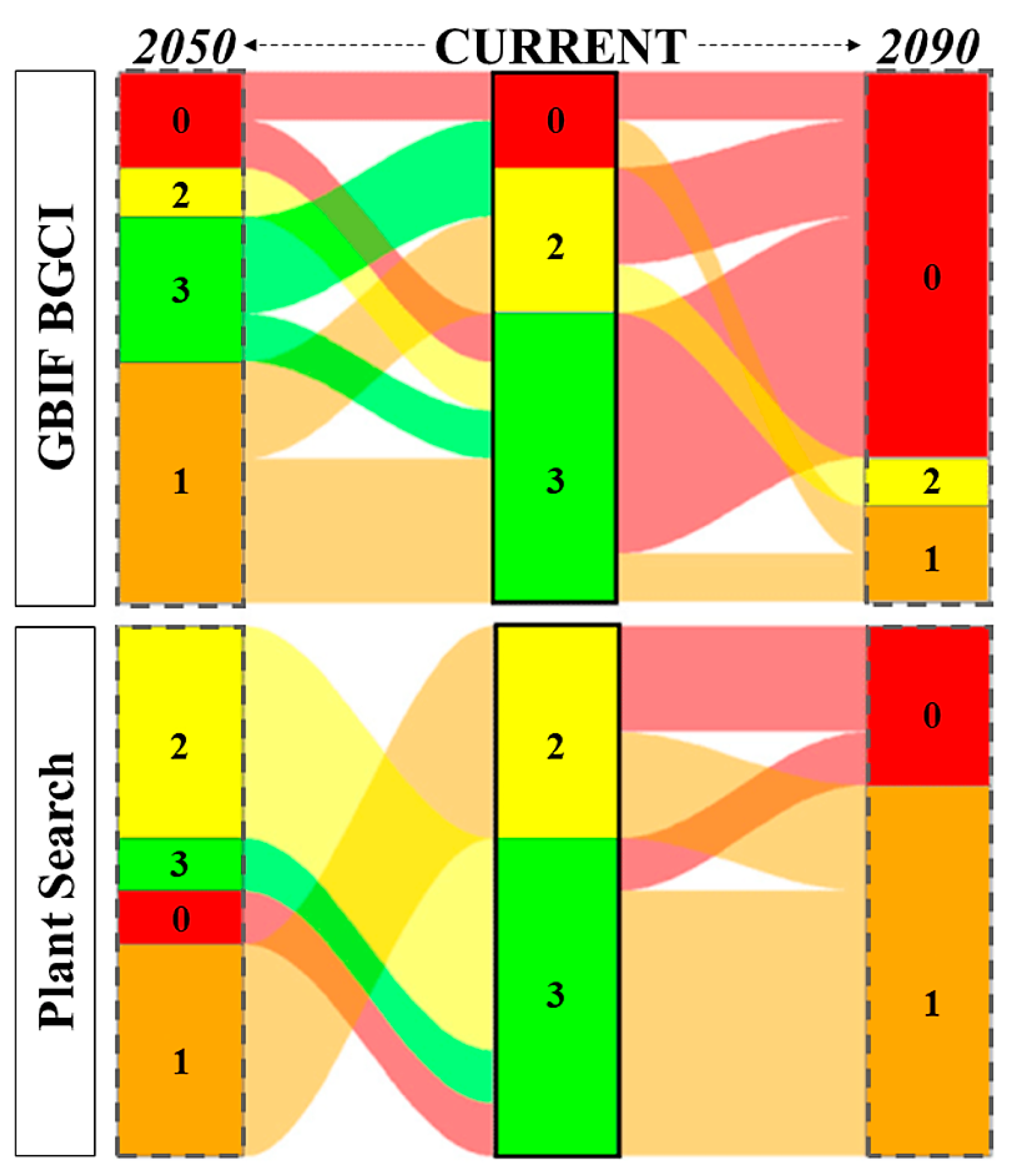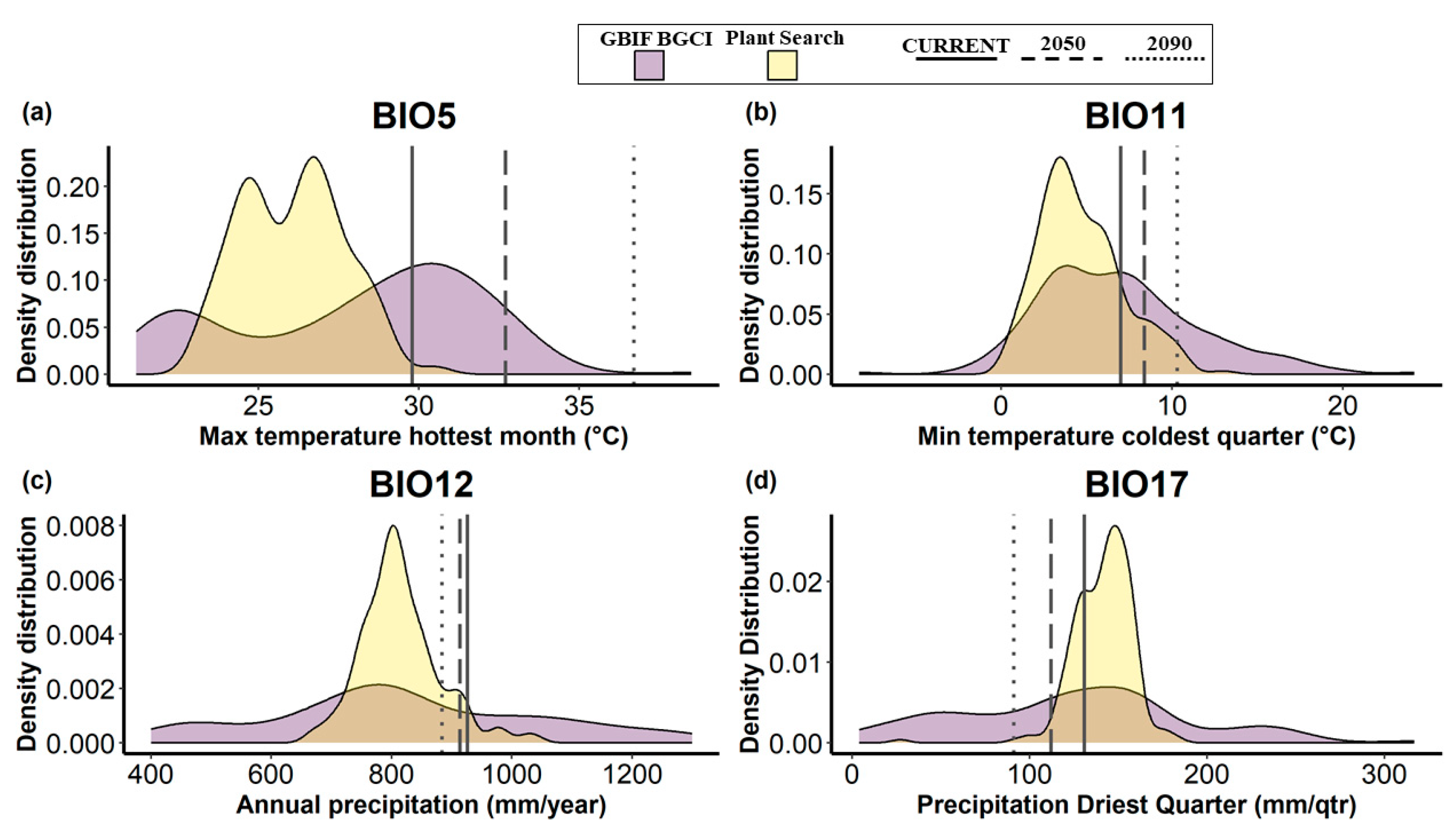The Trees of the Pisa Botanic Garden under Climate Change Scenarios: What Are We Walking into?
Abstract
:1. Introduction
2. Materials and Methods
2.1. Study Site
2.2. Statistical Analyses
- -
- Risk Code 0: indicates that there is no current record of this species growing at this MAT;
- -
- Risk Code 1: indicates that there are known records of this species growing at this MAT, but the latter is near the limit inferred from known records;
- -
- Risk Code 2: indicates that this species occurs at this MAT, albeit not optimal;
- -
- Risk Code 3: indicates that this species is mostly found growing at this MAT, which is expected to be optimal.
3. Results
4. Discussion
4.1. General Considerations
4.2. Why We Have to Be More Pessimistic than Predictions
4.3. Why We Can Be More Optimistic than Predictions
5. Conclusions
Supplementary Materials
Author Contributions
Funding
Institutional Review Board Statement
Informed Consent Statement
Data Availability Statement
Conflicts of Interest
References
- Bellard, C.; Bertelsmeier, C.; Leadley, P.; Thuiller, W.; Courchamp, F. Impacts of climate change on the future of biodiversity. Ecol. Lett. 2012, 15, 365–377. [Google Scholar] [CrossRef] [PubMed] [Green Version]
- Pörtner, H.-O.; Roberts, D.C.; Tignor, M.M.B.; Poloczanska, E.S.; Mintenbeck, K.; Alegría, A.; Craig, M.; Langsdorf, S.; Löschke, S.; Möller, V.; et al. Climate Change 2022: Impacts, Adaptation and Vulnerability. Contribution of Working Group II to the Sixth Assessment Report of the Intergovernmental Panel on Climate Change; Cambridge University Press: Cambridge, UK; New York, NY, USA, 2022. [Google Scholar]
- Simpson, N.P.; Mach, K.J.; Constable, A.; Hess, J.; Hogarth, R.; Howden, M.; Lawrence, J.; Lempert, R.J.; Muccione, V.; Mackey, B.; et al. A framework for complex climate change risk assessment. One Earth 2021, 4, 489–501. [Google Scholar] [CrossRef]
- Bedini, G.; Astuti, G.; Carta, A.; Ciccarelli, D.; D’Antraccoli, M.; Dolci, D.; Peruzzi, L. Sensitivity of wild plants to climate change. Agrochimica 2019, 2019, 165–170. [Google Scholar]
- Peruzzi, L.; Dolci, D.; Chiarucci, A. Potential climatic and elevational range shifts in the Italian narrow endemic Bellevalia webbiana (Asparagaceae) under climate change scenarios. Nat. Conserv. 2022, 50, 145–157. [Google Scholar] [CrossRef]
- Trenberth, K.E.; Dai, A.; Rasmussen, R.M.; Parsons, D.B. The changing character of precipitation. Bull. Am. Meteorol. Soc. 2003, 84, 1205–1218. [Google Scholar] [CrossRef]
- Primack, R.B.; Ellwood, E.R.; Gallinat, A.S.; Miller-Rushing, A.J. The growing and vital role of botanical gardens in climate change research. New Phytol. 2021, 231, 917–932. [Google Scholar] [CrossRef]
- Cannon, C.H.; Kua, C.-S. Botanic gardens should lead the way to create a “Garden Earth” in the Anthropocene. Plant Divers. 2017, 39, 331–337. [Google Scholar] [CrossRef]
- Culley, T.M.; Dreisilker, K.; Clair Ryan, M.; Schuler, J.A.; Cavallin, N.; Gettig, R.; Havens, K.; Landel, H.; Shultz, B. The potential role of public gardens as sentinels of plant invasion. Biodivers. Conserv. 2022, 31, 1829–1844. [Google Scholar] [CrossRef]
- Raschke, A.B.; Pegram, K.V.; Melkonoff, N.A.; Davis, J.; Blackwell, S.A. Collaborative conservation by botanical gardens: Unique opportunities for local to global impacts. J. Zool. Bot. Gard. 2022, 3, 463–487. [Google Scholar] [CrossRef]
- Chen, G.; Sun, W. The role of botanical gardens in scientific research, conservation, and citizen science. Plant Divers. 2018, 40, 181–188. [Google Scholar] [CrossRef]
- Hohn, T.C. Curatorial Practices for Botanical Gardens; Rowman Altamira: Walnut Creek, CA, USA, 2008; ISBN 978-0-7591-1063-2. [Google Scholar]
- Qumsiyeh, M.; Handal, E.; Chang, J.; Abualia, K.; Najajrah, M.; Abusarhan, M. Role of museums and botanical gardens in ecosystem services in developing countries: Case study and outlook. Int. J. Environ. Stud. 2017, 74, 340–350. [Google Scholar] [CrossRef]
- Wyse Jackson, P.; Sutherland, L. Role of botanic gardens. In Encyclopedia of Biodiversity; Levin, S.A., Ed.; Academic Press: Waltham, MA, USA, 2017; Volume 6, pp. 504–521. [Google Scholar]
- Symes, P.; Hart, C. The Climate Change Alliance: Botanic garden horticulturists as agents for change. Sibbaldia 2021, 20, 95–122. [Google Scholar] [CrossRef]
- Miller, A.J.; Novy, A.; Glover, J.; Kellogg, E.A.; Maul, J.E.; Raven, P.; Jackson, P.W. Expanding the role of botanical gardens in the future of food. Nat. Plants 2015, 1, 15078. [Google Scholar] [CrossRef] [PubMed]
- Golding, J.; Güsewell, S.; Kreft, H.; Kuzevanov, V.Y.; Lehvävirta, S.; Parmentier, I.; Pautasso, M. Species-richness patterns of the living collections of the world’s botanic gardens: A matter of socio-economics? Ann. Bot. 2010, 105, 689–696. [Google Scholar] [CrossRef] [PubMed]
- Christenhusz, M.J.M.; Byng, J.W. The number of known plants species in the world and its annual increase. Phytotaxa 2016, 261, 201–217. [Google Scholar] [CrossRef] [Green Version]
- Jackson, P.W.; Bridge, B.; Dennis, F.; Leadlay, E.; Hobson, C.; Holland, F.; Pendry, T.; Skilton, J.; Sutherland, L.; Willison, J.; et al. An international review of the ex situ plant collections of the botanic gardens of the world-: Reviewing the plant genetic resource collections of botanic gardens worldwide, as a contribution to decision V/26 on Access to Genetic Resources of the Conference of the Parties to the Convention on Biological Diversity—Part 1: Overview and analysis. Bot. Gard. Conserv. News 2001, 3, 22–33. [Google Scholar]
- Urban, M.C. Climate change. Accelerating extinction risk from climate change. Science 2015, 348, 571–573. [Google Scholar] [CrossRef] [Green Version]
- Gao, J.-G.; Liu, H.; Wang, N.; Yang, J.; Zhang, X.-L. Plant extinction excels plant speciation in the Anthropocene. BMC Plant Biol. 2020, 20, 430. [Google Scholar] [CrossRef]
- Oldfield, S.; Newton, A.C. Integrated Conservation of Tree Species by Botanic Gardens: A Reference Manual; Botanic Gardens Conservation International: Richmond, UK, 2012. [Google Scholar]
- Seidl, R.; Thom, D.; Kautz, M.; Martin-Benito, D.; Peltoniemi, M.; Vacchiano, G.; Wild, J.; Ascoli, D.; Petr, M.; Honkaniemi, J.; et al. Forest disturbances under climate change. Nat. Clim. Chang. 2017, 7, 395–402. [Google Scholar] [CrossRef] [Green Version]
- Oleson, K.W.; Bonan, G.B.; Feddema, J.; Jackson, T. An examination of urban heat island characteristics in a global climate model. Int. J. Climatol. 2011, 31, 1848–1865. [Google Scholar] [CrossRef] [Green Version]
- Ward, C.D.; Parker, C.M.; Shackleton, C.M. The use and appreciation of botanical gardens as urban green spaces in South Africa. Urban For. Urban Green. 2010, 9, 49–55. [Google Scholar] [CrossRef] [Green Version]
- Haase, D.; Larondelle, N.; Andersson, E.; Artmann, M.; Borgström, S.; Breuste, J.; Gomez-Baggethun, E.; Gren, Å.; Hamstead, Z.; Hansen, R.; et al. A quantitative review of urban ecosystem service assessments: Concepts, models, and implementation. AMBIO 2014, 43, 413–433. [Google Scholar] [CrossRef] [PubMed] [Green Version]
- Hall, C.; Knuth, M. An update of the literature supporting the well-being benefits of plants: A review of the emotional and mental health benefits of plants. J. Environ. Hortic. 2019, 37, 30–38. [Google Scholar] [CrossRef]
- Carrari, E.; Aglietti, C.; Bellandi, A.; Dibari, C.; Ferrini, F.; Fineschi, S.; Galeotti, P.; Giuntoli, A.; Manganelli Del Fa, R.; Moriondo, M.; et al. The management of plants and their impact on monuments in historic gardens: Current threats and solutions. Urban For. Urban Green. 2022, 76, 127727. [Google Scholar] [CrossRef]
- Xishuangbanna International Symposium Participants. The Xishuangbanna Declaration on Botanical Gardens and Climate Change. In Proceedings of the Third Xishuangbanna International Symposium, Botanical Gardens and Climate Change, Xishuangbanna, China, 13–16 January 2014; Available online: https://www.bgci.org/files/Worldwide/News/2014/XDBGCC.pdf (accessed on 15 November 2022).
- Entwisle, T.J. R-E-S-P-E-C-T: How Royal Botanic Gardens Victoria is responding to climate change. Plants People Planet 2019, 1, 77–83. [Google Scholar] [CrossRef] [Green Version]
- Esperon-Rodriguez, M.; Rymer, P.D.; Power, S.A.; Barton, D.N.; Cariñanos, P.; Dobbs, C.; Eleuterio, A.A.; Escobedo, F.J.; Hauer, R.; Hermy, M.; et al. Assessing climate risk to support urban forests in a changing climate. Plants People Planet 2022, 4, 201–213. [Google Scholar] [CrossRef]
- Climate Change Alliance of Botanic Gardens. Climate Assessment Tool v1. Available online: https://cat.bgci.org (accessed on 19 October 2022).
- BGCI PlantSearch Online Database. Available online: https://tools.bgci.org/plant_search.php (accessed on 20 December 2022).
- Bartolucci, F.; Peruzzi, L.; Galasso, G.; Albano, A.; Alessandrini, A.; Ardenghi, N.M.G.; Astuti, G.; Bacchetta, G.; Ballelli, S.; Banfi, E.; et al. An updated checklist of the vascular flora native to Italy. Plant Biosyst. 2018, 152, 179–303. [Google Scholar] [CrossRef]
- Galasso, G.; Conti, F.; Peruzzi, L.; Ardenghi, N.M.G.; Banfi, E.; Celesti-Grapow, L.; Albano, A.; Alessandrini, A.; Bacchetta, G.; Ballelli, S.; et al. An updated checklist of the vascular flora alien to Italy. Plant Biosyst. 2018, 152, 556–592. [Google Scholar] [CrossRef]
- WFO World Flora Online. Available online: http://www.worldfloraonline.org (accessed on 4 December 2022).
- IUCN. The IUCN Red List of Threatened Species. Available online: https://www.iucnredlist.org/en (accessed on 30 November 2022).
- Fick, S.E.; Hijmans, R.J. WorldClim 2: New 1-Km Spatial Resolution Climate Surfaces for Global Land Areas. Int. J. Climatol. 2017, 37, 4302–4315. [Google Scholar] [CrossRef]
- Crockett, J.L.; Westerling, A.L. Greater temperature and precipitation extremes intensify western U.S. droughts, wildfire severity, and Sierra Nevada tree mortality. J. Clim. 2018, 31, 341–354. [Google Scholar] [CrossRef]
- Zimmermann, N.E.; Yoccoz, N.G.; Edwards, T.C.; Meier, E.S.; Thuiller, W.; Guisan, A.; Schmatz, D.R.; Pearman, P.B. Climatic extremes improve predictions of spatial patterns of tree species. Proc. Natl. Acad. Sci. USA 2009, 106, 19723–19728. [Google Scholar] [CrossRef] [Green Version]
- Box, G.E.P. Science and Statistics. J. Am. Stat. Assoc. 1976, 71, 791–799. [Google Scholar] [CrossRef]
- Martin, S. Climate ready? Exploring the impacts and lessons from recent extreme events at Royal Botanic Garden Edinburgh for climate change adaptation in the horticulture sector. Sibbaldia 2014, 12, 155–170. [Google Scholar] [CrossRef]
- Felton, A.J.; Smith, M.D. Integrating plant ecological responses to climate extremes from individual to ecosystem levels. Philos. Trans. R. Soc. B Biol. Sci. 2017, 372, 20160142. [Google Scholar] [CrossRef] [PubMed] [Green Version]
- Beigaitė, R.; Tang, H.; Bryn, A.; Skarpaas, O.; Stordal, F.; Bjerke, J.W.; Žliobaitė, I. Identifying climate thresholds for dominant natural vegetation types at the global scale using machine learning: Average climate versus extremes. Glob. Chang. Biol. 2022, 28, 3557–3579. [Google Scholar] [CrossRef] [PubMed]
- Levitt, J. Responses of Plants to Environmental Stresses; Academic Press: New York, NY, USA, 1980; Volume 2. [Google Scholar]
- Polley, H.W.; Derner, J.D.; Jackson, R.B.; Wilsey, B.J.; Fay, P.A. Impacts of climate change drivers on C4 grassland productivity: Scaling driver effects through the plant community. J. Exp. Bot. 2014, 65, 3415–3424. [Google Scholar] [CrossRef] [Green Version]
- Gillner, S.; Bräuning, A.; Roloff, A. Dendrochronological analysis of urban trees: Climatic response and impact of drought on frequently used tree species. Trees 2014, 28, 1079–1093. [Google Scholar] [CrossRef]
- Doick, K.; Hutchings, T. Air temperature regulation by urban trees and green infrastructure. For. Res. 2013, 12, 1–10. Available online: https://cdn.forestresearch.gov.uk/2013/03/fcrn012.pdf. (accessed on 10 December 2022).
- Day, S.; Bassuk, N. A review of the effects of soil compaction and amelioration techniques on landscape trees. J. Arboric. 1994, 20, 9–17. [Google Scholar] [CrossRef]
- Gilman, E. Effects of amendments, soil additives, and irrigation on tree survival and growth. J. Arboric. 2004, 30, 301–304. [Google Scholar] [CrossRef]
- Entwisle, T.J.; Cole, C.; Symes, P. Adapting the botanical landscape of Melbourne Gardens (Royal Botanic Gardens Victoria) in response to climate change. Plant Divers. 2017, 39, 338–347. [Google Scholar] [CrossRef] [PubMed]
- Morar, T.; Luca, E.; Petrache, A.; Culescu, D. Tree inventory in the historical garden of Teleki castle using the tree plotter software. Agric. Rev. Știință Pract. Agric. 2019, 111, 418–422. [Google Scholar] [CrossRef]
- Çinar, H.; Guzel, M. Investigation on rational use of water in a palace garden: A case of Dolmabahce Palace (Mabeyn Garden). Fresenius Environ. Bull. 2020, 29, 6469–6478. [Google Scholar]
- Cheney, J.; Navarrete, J.; Wyse Jackson, P. Action Plan for Botanic Gardens in the European Union; Ministry for SMEs and Agriculture, Directorate of Research and Development, National Botanic Garden of Belgium: Meise, Belgium, 2000.
- Evans, P.S.; Klett, J.E. The effects of dormant branch thinning on total leaf, shoot, and root production from bare-root Prunus cerasifera ‘Newport’. J. Arboric. 1985, 11, 298–302. [Google Scholar]
- Gilman, E.; Grabosky, J. Branch union morphology affects decay following pruning. Arboric. Urban For. 2006, 32, 74–79. [Google Scholar] [CrossRef]
- Clark, J.; Matheny, N. The Research Foundation to tree pruning: A review of the literature. Arboric. Urban For. 2010, 36, 110–120. [Google Scholar] [CrossRef]
- Berg, M.P.; Ellers, J. Trait plasticity in species interactions: A driving force of community dynamics. Evol. Ecol. 2010, 24, 617–629. [Google Scholar] [CrossRef] [Green Version]
- Richter, S.; Kipfer, T.; Wohlgemuth, T.; Calderón Guerrero, C.; Ghazoul, J.; Moser, B. Phenotypic plasticity facilitates resistance to climate change in a highly variable environment. Oecologia 2012, 169, 269–279. [Google Scholar] [CrossRef]
- Anderegg, W.R.L.; Anderegg, L.D.L.; Kerr, K.L.; Trugman, A.T. Widespread drought-induced tree mortality at dry range edges indicates that climate stress exceeds species’ compensating mechanisms. Glob. Chang. Biol. 2019, 25, 3793–3802. [Google Scholar] [CrossRef]
- Delucia, E.H.; Maherali, H.; Carey, E.V. Climate-driven changes in biomass allocation in pines. Glob. Chang. Biol. 2000, 6, 587–593. [Google Scholar] [CrossRef]
- Markesteijn, L.; Poorter, L. Seedling root morphology and biomass allocation of 62 tropical tree species in relation to drought- and shade-tolerance. J. Ecol. 2009, 97, 311–325. [Google Scholar] [CrossRef]
- López, R.; López de Heredia, U.; Collada, C.; Cano, F.J.; Emerson, B.C.; Cochard, H.; Gil, L. Vulnerability to cavitation, hydraulic efficiency, growth and survival in an insular pine (Pinus canariensis). Ann. Bot. 2013, 111, 1167–1179. [Google Scholar] [CrossRef] [PubMed] [Green Version]
- Anderegg, W.R.L. Spatial and temporal variation in plant hydraulic traits and their relevance for climate change Impacts on Vegetation. New Phytol. 2015, 205, 1008–1014. [Google Scholar] [CrossRef] [PubMed]
- Royal Botanic Gardens Victoria. Landscape Succession Strategy Melbourne Gardens 2016–2036. Available online: https://www.rbg.vic.gov.au/media/p41mwqcw/landscape_succession_strategy_lo_res1.pdf (accessed on 23 December 2022).





| Model | Scenario | Worsening (%) | Stable (%) | Improving (%) |
|---|---|---|---|---|
| GBIF BGCI | SSP2/RCP4.5 (2050) | 36.5 | 27.5 | 36.0 |
| Plant Search | SSP3/RCP7.0 (2050) | 49.0 | 50.5 | 0.5 |
| GBIF BGCI | SSP2/RCP4.5 (2090) | 51.9 | 21.7 | 26.5 |
| Plant Search | SSP3/RCP7.0 (2090) | 95.9 | 4.1 | 0.0 |
Disclaimer/Publisher’s Note: The statements, opinions and data contained in all publications are solely those of the individual author(s) and contributor(s) and not of MDPI and/or the editor(s). MDPI and/or the editor(s) disclaim responsibility for any injury to people or property resulting from any ideas, methods, instructions or products referred to in the content. |
© 2023 by the authors. Licensee MDPI, Basel, Switzerland. This article is an open access article distributed under the terms and conditions of the Creative Commons Attribution (CC BY) license (https://creativecommons.org/licenses/by/4.0/).
Share and Cite
D’Antraccoli, M.; Weiger, N.; Cocchi, L.; Peruzzi, L. The Trees of the Pisa Botanic Garden under Climate Change Scenarios: What Are We Walking into? Sustainability 2023, 15, 4585. https://doi.org/10.3390/su15054585
D’Antraccoli M, Weiger N, Cocchi L, Peruzzi L. The Trees of the Pisa Botanic Garden under Climate Change Scenarios: What Are We Walking into? Sustainability. 2023; 15(5):4585. https://doi.org/10.3390/su15054585
Chicago/Turabian StyleD’Antraccoli, Marco, Nóra Weiger, Leonardo Cocchi, and Lorenzo Peruzzi. 2023. "The Trees of the Pisa Botanic Garden under Climate Change Scenarios: What Are We Walking into?" Sustainability 15, no. 5: 4585. https://doi.org/10.3390/su15054585
APA StyleD’Antraccoli, M., Weiger, N., Cocchi, L., & Peruzzi, L. (2023). The Trees of the Pisa Botanic Garden under Climate Change Scenarios: What Are We Walking into? Sustainability, 15(5), 4585. https://doi.org/10.3390/su15054585








